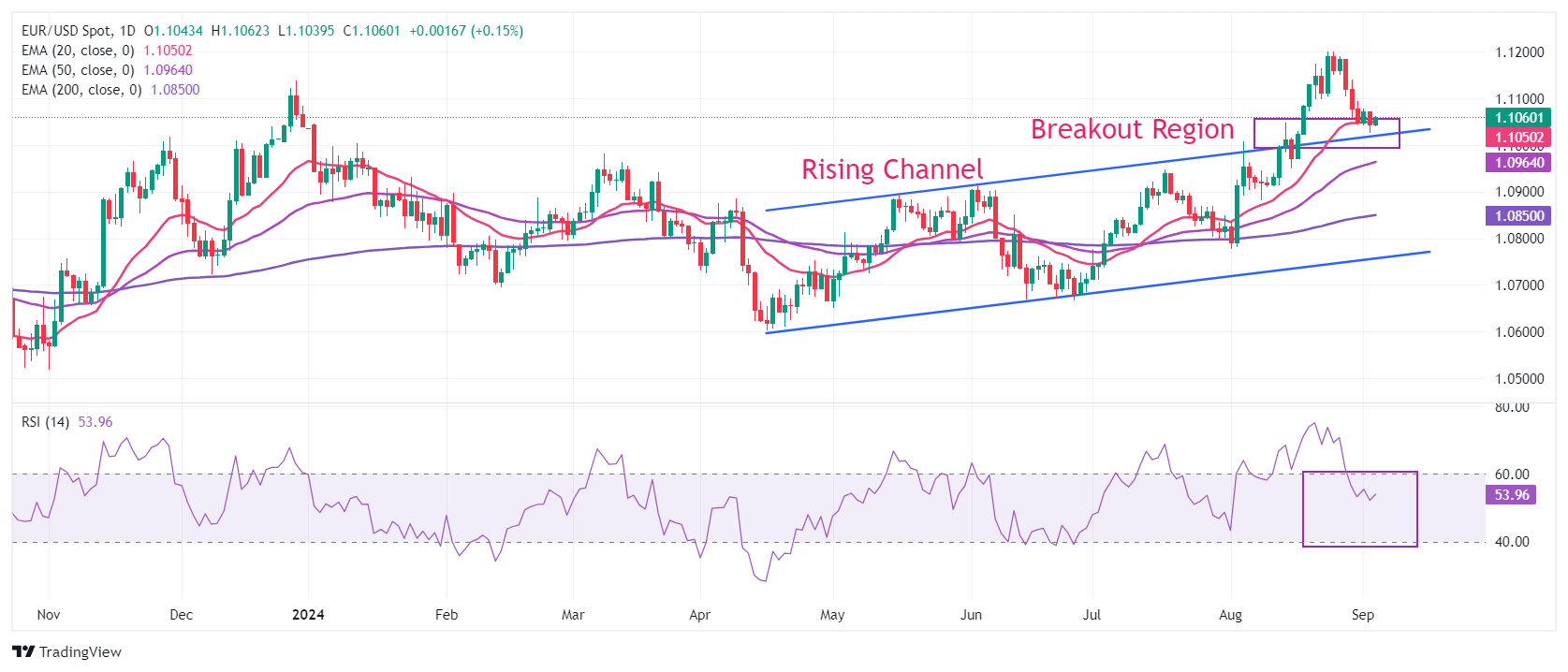
- EUR/USD finds a temporary cushion near 1.1030 amid a slight correction in the US Dollar.
- The US Dollar falls as the US ISM Manufacturing PMI data signaled a contraction in activity for the fifth month in a row.
- Investors await the US JOLTS Job Openings data for July.
EUR/USD recovers slightly in European trading hours amid a gradual correction in the US Dollar. The Euro’s (EUR) near-term outlook remains downbeat as market participants expect that the European Central Bank’s (ECB) policy-easing cycle could be aggressive given the steep decline in Eurozone inflationary pressures and weak economic growth.
Economists at Bank of America (BofA) said in their latest report about the Eurozone: “We still see more cuts in 2025/26 than the markets are pricing, with a return to a deposit rate of 2% by 3Q25 (at the latest) and to 1.5% in 2026.” BofA said that Europe’s recovery remains fragile and will likely be shallow, pressured by several economic factors such as slowing growth in China as well as politics.
ECB officials also remain worried about increasing risks to Eurozone economic growth. ECB Executive board member Piero Cipollone said in an interview with a French newspaper said that there is a real risk that our stance could become too restrictive,” adding that, “we must ensure that inflation converges to our target without holding back the economy unnecessarily,” Reuters reported.
On the economic front, investors await the Eurozone Retail Sales data for July, which will be published on Thursday. Economists estimate the Retail Sales to have grown by 0.1% after contracting 0.3% in June on a monthly as well as an annual basis. A slight improvement in sales at retail stores would be insufficient to dampen market speculation that the ECB will resume its policy-easing cycle this month, which it started in June, after pausing in July.
Meanwhile, the Eurozone Producer Price Index (PPI) data came in better than projected in July. The PPI report showed that prices of goods and services at factory gates were deflated at a slower pace of 2.1% from the estimates of 2.5% and July’s reading of 3.2%. No matter the pace of decline in prices of goods and services fall, it would prompt expectations of ECB rate cuts in September.
Daily digest market movers: EUR/USD finds buying interest as US Dollar delivers moderate correction
- EUR/USD discovers buying interest in Wednesday’s European session after posting a fresh two-week low near 1.1025 on Tuesday. The major currency pair edges higher as the US Dollar (USD) corrects after the release of the United States (US) ISM Manufacturing PMI data for August. The US Dollar Index (DXY), which tracks the Greenback’s value against six major currencies, falls to near 101.60 after failing to reclaim a two-week high of 102.00.
- The ISM Manufacturing PMI, released on Tuesday, came in at 47.2, missing estimates of 47.5 but improving from an eight-month low of 46.8. Despite the slight improvement, markets considered that the overall trend points to a slowdown as a figure below 50.0 suggests a contraction in manufacturing activity.
- Amid a data-heavy week, investors keenly await the US Nonfarm Payrolls (NFP) data for August, which will be published on Friday. The official labor market data will shape the Federal Reserve’s (Fed) interest rate cut path for September. Investors seem to be confident that the Fed will start reducing its key borrowing rates this month but are divided over the size of this potential rate cut.
- The importance of the labor market data has increased significantly after the commentary from Fed Chair Jerome Powell at the Jackson Hole (JH) Symposium, who signalled that the central bank is very much concerned about weakening labor demand.
- For more insights on the current labor market status, investors will also focus on the US JOLTS Job Opening data for July and the ADP Employment Change data for August, which will be published at 14:00 GMT and on Thursday, respectively.
- The US JOLTS Job Openings report is expected to show that employers posted 8.1 million fresh job vacancies, marginally lower than the 8.184 million a month earlier.
Technical Analysis: EUR/USD hovers near 20-day EMA
EUR/USD recovers slightly after posting a fresh two-week low near 1.1025. The near-term outlook of the major currency pair is uncertain as it struggles to gain firm footing near the 20-day Exponential Moving Average (EMA) around 1.1020.
The longer-term outlook is still bullish as the 50-day and 200-day EMAs at 1.0964 and 1.0850, respectively, are sloping higher. Also, the shared currency pair holds the Rising Channel breakout on a daily time frame.
The 14-day Relative Strength Index (RSI) has declined below 60.00 after turning overbought near 75.00.
On the upside, the recent high of 1.1200 and the July 2023 high at 1.1275 will be the next stop for the Euro bulls. Meanwhile, the downside is expected to remain cushioned near the psychological support of 1.1000.
Economic Indicator
Nonfarm Payrolls
The Nonfarm Payrolls release presents the number of new jobs created in the US during the previous month in all non-agricultural businesses; it is released by the US Bureau of Labor Statistics (BLS). The monthly changes in payrolls can be extremely volatile. The number is also subject to strong reviews, which can also trigger volatility in the Forex board. Generally speaking, a high reading is seen as bullish for the US Dollar (USD), while a low reading is seen as bearish, although previous months’ reviews and the Unemployment Rate are as relevant as the headline figure. The market’s reaction, therefore, depends on how the market assesses all the data contained in the BLS report as a whole.


